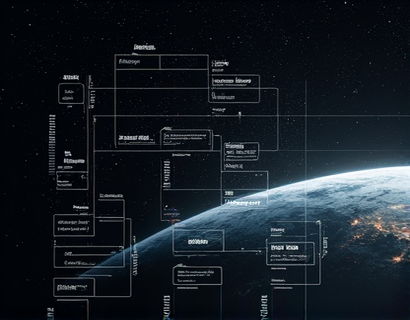Unlocking Economic Prosperity in Modern Ecosystems: Strategic Insights for Market Success
In the rapidly evolving landscape of global economics, understanding the dynamics of modern ecosystems is crucial for professionals aiming to navigate and capitalize on emerging market opportunities. This guide delves into the intricate economic dynamics that define these ecosystems, offering strategic insights and detailed analysis to assist economists, business leaders, investors, and industry experts in staying competitive and informed.
The concept of an ecosystem in an economic context refers to a complex network of interconnected entities including businesses, consumers, suppliers, and regulatory bodies, all interacting within a specific geographic or thematic boundary. These ecosystems are characterized by their adaptability, innovation, and resilience, which are key drivers of economic prosperity.
Understanding Modern Economic Ecosystems
Modern economic ecosystems are far more dynamic and interconnected than their traditional counterparts. They leverage technology, data, and global connectivity to foster innovation and growth. These ecosystems are not confined by physical borders but are often defined by shared industries, technologies, or markets.
A key feature of these ecosystems is the presence of keystone institutions—entities that play a critical role in maintaining the structure and function of the ecosystem. These can be large corporations, research institutions, or government agencies that provide essential services, set standards, and drive innovation.
Drivers of Economic Prosperity in Ecosystems
Several factors contribute to the economic prosperity of modern ecosystems. First, innovation is a cornerstone. Continuous innovation in products, services, and processes keeps the ecosystem vibrant and competitive. This innovation is often driven by collaboration between different players within the ecosystem, including startups, established companies, and academic institutions.
Second, a skilled workforce is essential. Ecosystems that attract and retain talent through education, training, and a high quality of life can sustain long-term growth. The availability of a diverse and skilled labor pool enables businesses to adapt and innovate, further driving economic prosperity.
Third, robust infrastructure supports the smooth functioning of the ecosystem. This includes physical infrastructure like transportation and telecommunications, as well as institutional infrastructure such as regulatory frameworks and financial systems. Efficient infrastructure reduces costs and enhances connectivity, facilitating trade and investment.
Strategic Insights for Navigating Market Success
For professionals looking to identify and capitalize on emerging market opportunities, understanding the following strategic insights is crucial:
- Embrace Collaboration: Success in modern ecosystems often hinges on collaboration. Businesses should seek partnerships that leverage complementary strengths, whether in technology, market access, or expertise. Collaborative projects can accelerate innovation and reduce risks.
- Focus on Sustainability: Sustainability is no longer a niche concern but a core component of long-term success. Ecosystems that integrate sustainable practices not only contribute to environmental health but also appeal to a growing base of consumers and investors who prioritize sustainability.
- Leverage Data and Technology: Data-driven decision-making is essential in today’s ecosystems. Utilizing advanced analytics, artificial intelligence, and other technologies can provide insights that inform strategy, optimize operations, and create new value propositions.
- Adapt to Change: Flexibility and adaptability are vital. Ecosystems are dynamic, and the ability to pivot in response to changing market conditions, technological advancements, or regulatory shifts can mean the difference between success and obsolescence.
- Build Strong Networks: Networking is key to accessing resources, information, and opportunities. Professionals should actively engage with industry groups, attend conferences, and participate in online forums to build and maintain valuable connections.
Case Studies of Successful Ecosystems
Examining successful ecosystems can provide valuable lessons. One notable example is the Silicon Valley tech ecosystem. Its success can be attributed to a combination of factors including a concentration of top-tier universities, a culture of risk-taking and innovation, and a supportive infrastructure.
Another example is the biotech ecosystem in Boston, Massachusetts. This ecosystem thrives due to the presence of leading research institutions like Harvard and MIT, a robust network of biotech firms, and significant investment from venture capitalists. The synergy between these elements has made Boston a global hub for biotechnology innovation.
Challenges and Opportunities
While modern economic ecosystems offer numerous opportunities, they also present challenges. One major challenge is the rapid pace of change, which can be disruptive for businesses and workers alike. Continuous learning and upskilling are necessary to keep pace with technological advancements and market shifts.
Another challenge is the issue of inequality. As some regions and sectors thrive, others may lag behind, leading to economic disparities. Addressing these inequalities requires targeted policies and investments to ensure inclusive growth.
Despite these challenges, the opportunities are vast. The rise of digital technologies, the growing importance of sustainability, and the increasing interconnectedness of global markets present unprecedented chances for innovation and growth. Professionals who can navigate these dynamics effectively will be well-positioned for success.
Conclusion
Unlocking the potential of modern economic ecosystems requires a deep understanding of their dynamics and a strategic approach to leveraging opportunities. By embracing collaboration, focusing on sustainability, leveraging data and technology, adapting to change, and building strong networks, professionals can navigate the complex landscape of today’s economies.
As the global economic landscape continues to evolve, those who stay informed and agile will be best equipped to capitalize on emerging market opportunities and drive economic prosperity.










































